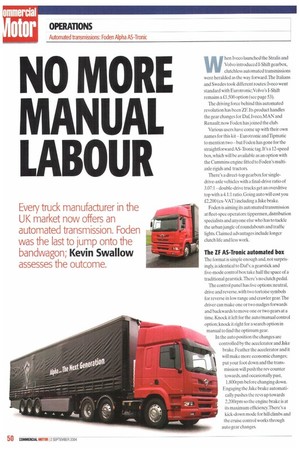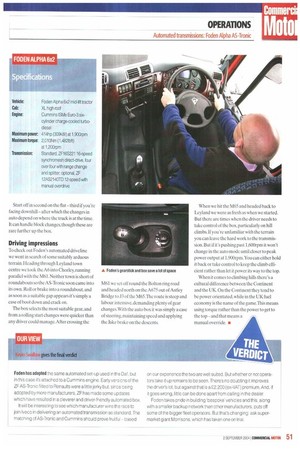NO MORE MANUAL LABOUR
Page 50

Page 51

If you've noticed an error in this article please click here to report it so we can fix it.
Every truck manufacturer in the UK market now offers an automated transmission. Foden was the last to jump onto the
bandwagon; Kevin Swallow
assesses the outcome.
When Iveco launched the Stralis and Volvo introduced 1-Shift gearbox, clutchless automated transmissions were heralded as the way forward.The Italians and Swedes took different routes: Iveco went standard with Eurotronic;Volvo's I-Shift remains a 0,500 option (see page 53).
The driving force behind this automated revolution has been ZF. Its product handles the gear changes for Daf,Iveco,MAN and Renault; now Foden has joined the club.
Various users have come up with their own names for this kit —Eurotronic and Tipmatic to mention two— but Foden has gone for the straightforward AS-Tronic tag. It's a 12-speed box, which will be available as an option with the Cummins engine fitted to Foden's multiaxle rigids and tractors.
There's a direct-top gearbox for singledrive-axle vehicles with a final-drive ratio of 3.07:1 — double-drive trucks get an overdrive top with a 4.1:1 ratio. Going auto will cost you 12,200 (ex-VAT) including a Jake brake.
Foden is aiming its automated transmission at fleet-spec operators: tippermen, distribution specialists and anyone else who has to tackle the urban jungle of roundabouts and traffic lights. Claimed advantages include longer clutch life and less work.
The ZF AS-Ironic automated box
The format is simple enough and, not ingly, is identical to Des; a gearstick and five-mode control box take half the space of a traditional gearstick.There's no clutch pedal. The control panel has five options: neutral, drive and reverse,with two tortoise symbols for reverse in low range and crawler gear. The driver can make one or two nudges forwards and backwards to move one or two gears at a time. Knock it left for the auto/manual control option; knock it right for a search option in manual to find the optimum gear.
In the auto position the changes are controlled by the accelerator and Jake brake. Feather the accelerator and it will make more economic changes; put your foot down and the trans mission will push the rev counter towards, and occasionally past, 1.800rpm before changing down.
Engaging the Jake brake automatically pushes the revs up towards 2,200rpm so the engine brake is at its maximum efficiency There's a kick-down mode for hill climbs and the cruise control works through auto gear changes. Start off in second on the flat — third if you're facing downhill — after which the changes in auto depend on where the truck is at the time. It can handle block changes, though these are rare further up the box.
Driving impressions
To check out Foden's automated driveline we went in search of some suitably arduous terrain. Heading through Leyland town centre we took the A6 into Chorley. running parallel with the M61. Neither town is short of roundabouts so the AS-Tronic soon came into its own. Roll or brake into a roundabout, and as soon as a suitable gap appears it's simply a case of boot down and crack on.
The box selects the most suitable gear, and from a rolling start changes were quicker than any driver could manage. After crossing the M61 we set off round the Bolton ring road and headed north on the A675 out of Astley Bridge to J3 of the M65.The route is steep and labour intensive, demanding plenty of gear changes. With the auto box it was simply a case of steering, maintaining speed and applying the Jake brake on the descents. When we hit the M65 and headed back to Leyland we were as fresh as when we started. But there are times when the driver needs to take control of the box, particularly on hill climbs. If you're unfamiliar with the terrain you can leave the hard work to the transmission. But if it's pushing past 1,600rpm it won't change in the auto mode until closer to peak power output at 1.900rpm. You can either hold it back or take control to keep the climb efficient rather than let it power its way to the top.
When it comes to climbing hills there's a cultural difference between the Continent and the UK. On the Continent they tend to be power orientated, while in the UK fuel economy is the name of the game.This means using torque rather than the power to get to the top —and that means a manual override. •




























































































































































































